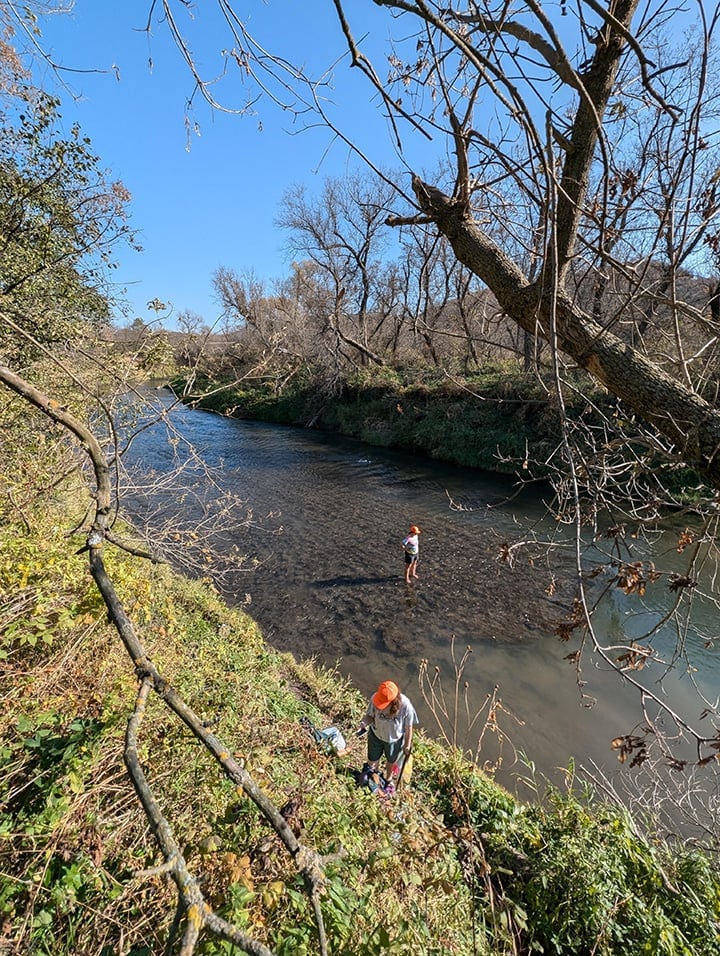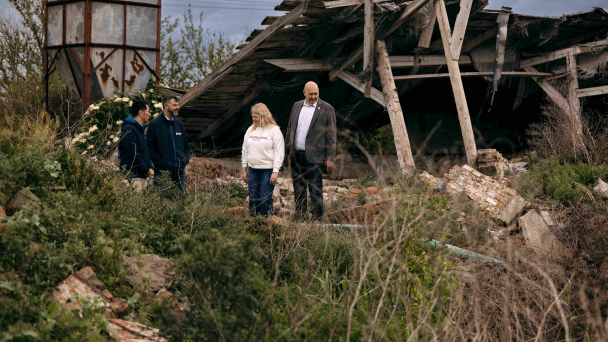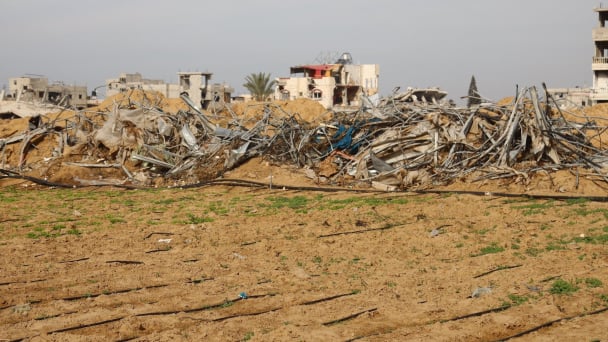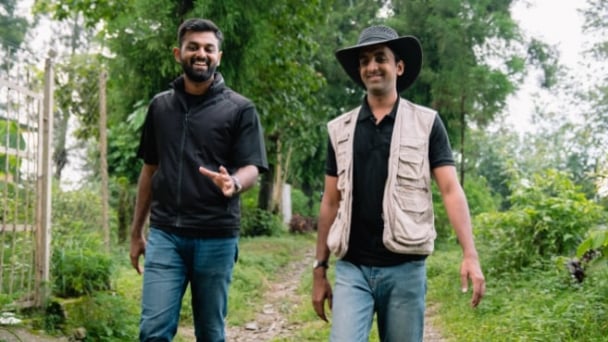June 12, 2025 | 17:24 GMT +7
June 12, 2025 | 17:24 GMT +7
Hotline: 0913.378.918
June 12, 2025 | 17:24 GMT +7
Hotline: 0913.378.918
Few forces rival a glacier’s erosive power. Some 20,000 years ago, during the last glacial maximum, the Laurentide Ice Sheet blanketed much of North America, gouging the land and carving the Great Lakes. But a study published this month in Geology finds that settlers over the past 150 years have altered the landscape far more dramatically, scooping away earth up to 12 times faster than the Laurentide and the quiet millennia that followed. What’s at stake, scientists say, isn’t just the landscape. It’s our food.

Emma Trettin, a master’s student at Minnesota State University, Mankato, stands in Minnesota’s Trout Creek, whose riverbed marks the height of the soil surface during the late 1850s. The creek’s 3-meter-tall banks are formed from eroded sediments, built up from the 19th century onward from land use practices.
“Agricultural erosion is one of the most overlooked yet profound human impacts on the environment. How long do we let the system run in a deficit before it catches up with us?” says David Montgomery, a geologist at the University of Washington who wasn’t involved with the study. “This is an exceptional dataset that links a pivotal moment in geologic history to the modern era.”
The new study, based on sediment records in a Minnesota river valley, contributes to a growing consensus across the Midwest and North America that European settlement profoundly shaped the continent. The work focuses on the state’s Upper Mississippi River Valley: a watershed that saw unsustainable, extraordinary erosion during the 1930s Dust Bowl. In the small farming town of Beaver, for example, floods repeatedly washed sediment into the streets—28 times in 1938 alone. By 1940, with up to 4.5 meters of sediment nearly burying buildings, residents abandoned their town as the state converted the land to a game reserve.
Early investigations blamed Beaver’s misfortunes on poor farming methods and other land use practices. But in the decades since, researchers haven’t been able to fully quantify humans’ contribution to Minnesota’s historical erosion because they lacked a prehistoric baseline.
So Dartmouth College geologist Shanti Penprase and her colleagues sampled river terraces—stairlike remnants of ancient floodplains—at Trout Creek, a waterway within the Upper Mississippi River Valley that lies just beyond the Laurentide’s former edge. By pairing two different techniques, the team assessed how quickly Trout Creek’s watershed eroded and when sediment was buried on the nearby floodplain.
One of the techniques, optically stimulated luminescence, tracks when each sample last saw sunlight, capturing its burial time on the floodplain. The other, known as cosmogenic radionuclide analysis, helps determine how quickly material eroded from surrounding hillslopes above the river terraces. As high-energy particles from space known as cosmic rays rain down on Earth’s surface, they cause beryllium-10, a radioactive isotope, to build up in hillslope sediments.
The longer these sediments stay exposed, the more beryllium-10 they collect, like a hunk of meat accumulating char as it slowly roasts on a spit. Sediments that linger on the surface readily build up beryllium-10—but in quickly eroded material, the isotope is relatively scant. “It’s sort of like making chicken shawarma,” says Penprase, borrowing an analogy from her former colleague Jeffrey Kwang. “During the lunch rush, the meat gets carved faster than it can roast.”
The resulting timeline shows that at Trout Creek, natural erosion peaked during the Laurentide’s maximum extent about 22,000 years ago, averaging 0.071 millimeters per year—about the thickness of a human hair. As the tundra thawed, glaciers retreated, and forests returned, erosion slowed to just 0.05 millimeters per year and remained low for millennia.
That changed abruptly in the late 1800s, when settlers cleared forests, plowed prairies, and introduced monoculture—or single-crop—farming in the region. Previous studies had found that erosion rates soared to nearly 4 millimeters per year—a 60-fold jump that may be an underestimate itself. Penprase and her colleagues settled on a more conservative postsettlement erosion rate of 0.6 millimeters per year, which is still eight to 12 times higher than ice-age averages.
“In less than 200 years, we’ve reshaped the land about 10 times faster than the glacial period did,” says study co-author Andrew Wickert, a geologist at the University of Minnesota Twin Cities. “Humans have been here since the ice retreated, but we don’t see significant erosion until plow-based agriculture began.”
Scientists caution this isn’t just a historical reckoning. Despite many advances in farming practices since the Dust Bowl, including the use of cover crops, no-till methods, and contour plowing, modern erosion still far exceeds natural, prehistoric rates. The U.S. Department of Agriculture considers up to 1 millimeter per year of erosion tolerable: a level that’s 14 times higher than Trout Creek’s peak glacial rates.
Modern levels of erosion could spell trouble by stripping fertile topsoil, clogging waterways, and weakening the soil’s ability to retain moisture and sequester carbon, says William Rapuc, a geologist at Savoie Mont Blanc University who wasn’t involved in the study. Perhaps most importantly, experts warn that long-term food security is at risk. “Soil,” Rapuc says, “is where we develop our societies.”
science

(VAN) As of Friday, a salmonella outbreak linked to a California egg producer had sickened at least 79 people. Of the infected people, 21 hospitalizations were reported, U.S. health officials said.

(VAN) With the war ongoing, many Ukrainian farmers and rural farming families face limited access to their land due to mines and lack the financial resources to purchase needed agricultural inputs.

(VAN) Vikas Rambal has quietly built a $5 billion business empire in manufacturing, property and solar, and catapulted onto the Rich List.

(VAN) Available cropland now at less than five percent, according to latest geospatial assessment from FAO and UNOSAT.

(VAN) Alt Carbon has raised $12 million in a seed round as it plans to scale its carbon dioxide removal work in the South Asian nation.

(VAN) Attempts to bring down the price of the Japanese staple have had little effect amid a cost-of-living crisis.

(VAN) Fourth most important food crop in peril as Latin America and Caribbean suffer from slow-onset climate disaster.